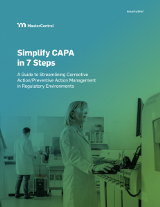
GxP Lifeline
The CAPA Process Magnificent Seven

The 1960 classic “The Magnificent Seven” features a small town that hires seven gunslingers to defend it from a gang of bandits, led by Calvera. Visits from the gang are a recurring problem for the town. The villagers finally have enough and decide to buy weapons and defend themselves, but eventually hire gunmen to help. With the help of the professionals, Calvera and his band are defeated, and our surviving heroes ride off into the proverbial sunset.
It’s a great movie, but why tie it to corrective action/preventive action? CAPAs can be the Calvera of the quality department. You can’t get rid of CAPAs entirely, but by adopting best practices and CAPA tools you can simplify your CAPA process, reduce the number of CAPAs you have, and make the process more efficient and effective.
#1: Identification
Identifying the problem may seem straightforward enough, but it’s important to thoroughly record all pertinent information. The source of the information for the quality event needs to be included as well. For example, if a deviation grows up to be a CAPA, the information about the deviation will be vital to the rest of the CAPA process. Ideally, all of this information will be stored electronically in CAPA software and linked to prevent data entry errors and make it easy to find in the future.
#2: Evaluation
Once you’ve identified the issue, you need to record it with as much detail as needed. This should strike a balance between being sufficiently detailed, but still succinct. The evaluation needs to include the following steps:
- Document evidence.
- Determine action.
- Forecast potential impact.
- Assess risk.
- Take remedial action.
The villagers in the Magnificent Seven might’ve not written up a formal report, but they did determine what action they were going to take after assessing the risks of doing nothing. For life sciences companies, a CAPA management system helps with the documentation, risk assessment, and entire CAPA process.
#3: CAPA Investigation
A turning point in The Magnificent Seven is when the villagers decide to surrender to Calvera because they’re afraid. The villagers didn’t all have the same level of commitment to fighting, so eventually their resolve crumbled, making the corrective action ineffective.
This ties directly into the first of the CAPA investigation fundamentals. These include:
- Gain organizational commitment.
- Integrate root cause analysis into quality systems.
- Train key personnel in root cause analysis.
- Provide reinforcement and appropriate tools.
These principles set a good foundation for the investigation that will follow. Without them, it’s unlikely that an investigator can get to the root cause or permanently implement any action. With this framework in place, companies next need a CAPA investigation plan that will include the objective, procedure, personnel, and resources needed.
#4: Analysis
Finding the root cause is essential to a CAPA investigation. Without it, the real problem is never solved or fully understood. Determining root cause comes down to three basic steps:
- List possible causes.
- Organize results and data.
- Conduct root cause analysis.
The third step involves asking the question “Why?” repeatedly. In some cases, this can require quite a bit of digging and is much easier to track in a CAPA management system. It isn’t enough to know how to fix the problem if you can’t figure out why it happened in the first place. For instance, when the villagers meet up with Chris, he helps them realize their best bet is to hire gunmen instead of purchasing guns. However, the defenselessness of the villagers is still a root cause, which is rectified by Chris and the others later in the movie as they teach them to fight.
#5: Creation of a CAPA Action Plan
Based on the analysis, you need to determine what to do and create an action plan around that. The plan needs to include:
- Actions to be completed.
- Documentation or specification changes.
- Process, procedure, or system changes.
- Employee training.
- Monitors/controls.
The villagers’ action plan is seemingly much simpler than one that would be required at a life sciences company, but it did require smaller actions supporting the larger overall goal. To get rid of Calvera, the villagers hire the gunmen, learn how to use guns themselves, build walls around the village, and set up an early warning system.
Any change in a life sciences company will be more involved. Standard operating procedures (SOPs) and work instructions should reflect changes and interrelated processes need to be changed as well. Then there will be training on those changes and ways to monitor whether the changes are working. Much of this can be automated by CAPA software, ensuring nothing falls through the cracks.
#6: Implementation of the CAPA Action Plan
Now that you have a plan, it’s time to carry it out. This step requires very little explanation but should include documentation showing what you’re doing. An implementation summary and supplementary documentation should be included. The implementation summary records everything from the action plan as it’s being carried out. The supplementary document is concerned with documents or other specifications that have been modified during the CAPA process.
#7: Follow-Up
Admittedly, there is no follow-up in the Magnificent Seven. In that situation, it hardly seems warranted since, spoiler alter, Calvera dies. Properly handled CAPA shouldn’t result in death by CAPA, so follow-up is needed. The point of the follow-up is to determine what the results of the actions were and whether they were effective. The key to this, and most of the CAPA process, is documentation, which can be automated and simplified with CAPA software.
CAPA software can handle the entire CAPA process, ensuring you don’t lose any information from when the original quality event happens, to when it escalates to a CAPA, through the investigation process, and to follow-up. By connecting this system to your documentation and training management, you can ensure SOPs get updated quickly and that training on a new process is sent out automatically.

